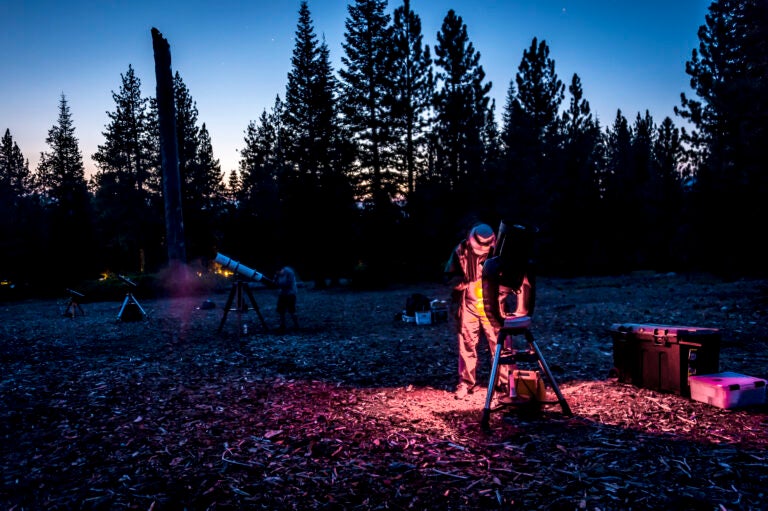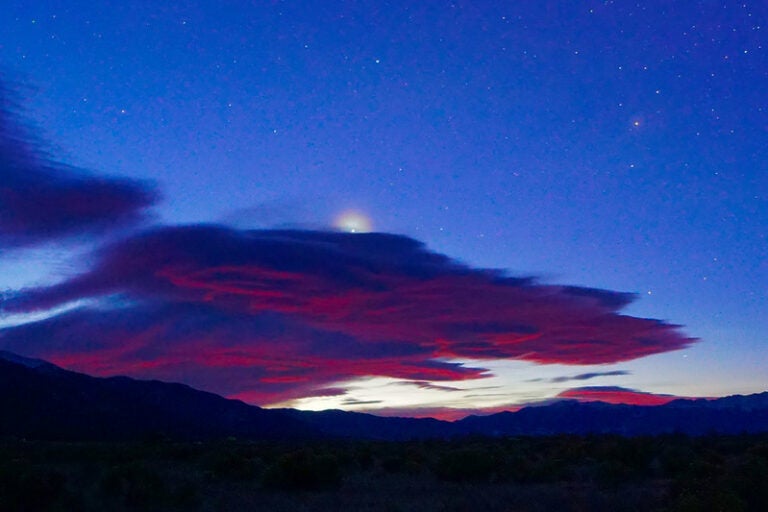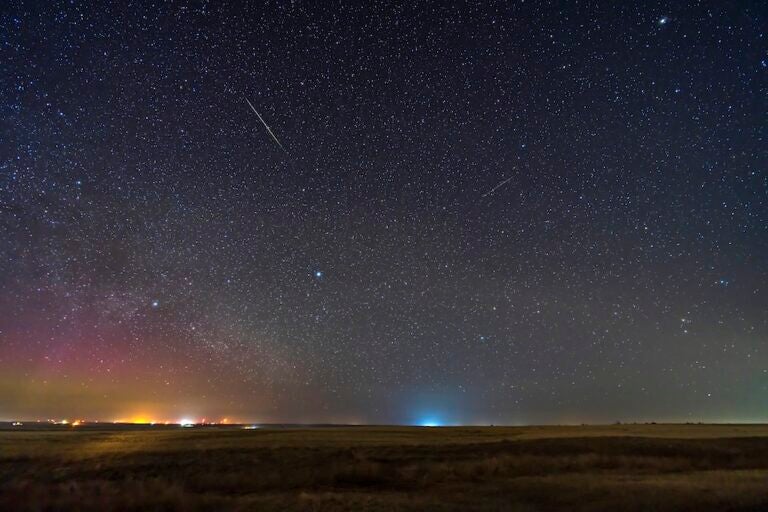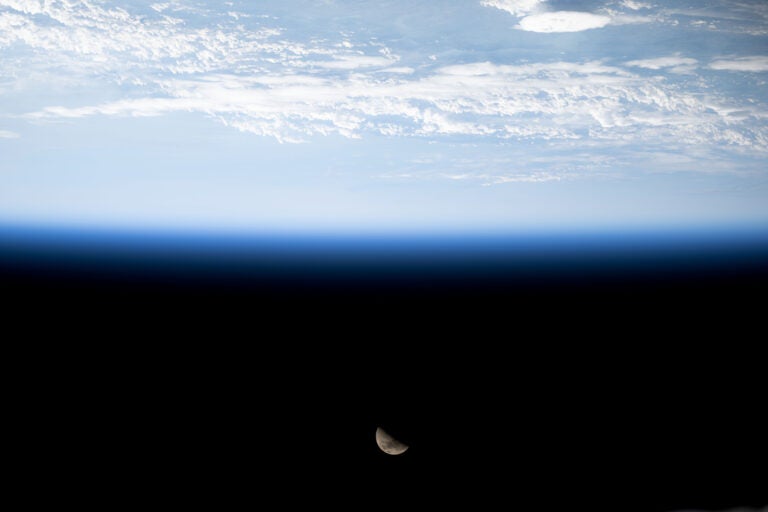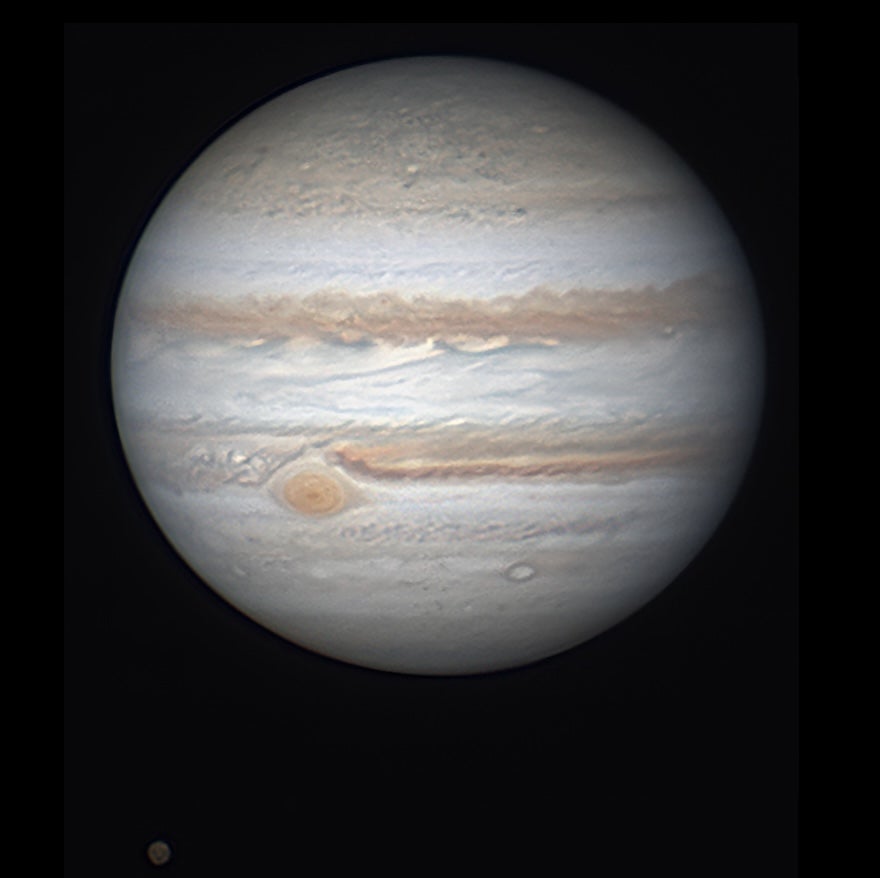
Friday, October 25
Venus passes 3° north of Antares at 3 P.M. EDT. The pair is very low in the southwest, but if you’ve got a clear horizon, both should be visible some 40 minutes after sunset. Venus stands out first, glowing a brilliant magnitude –4. Compare its light to dimmer, magnitude 1.1 Antares, to the planet’s lower left. Antares is a red giant star, and its light appears noticeably red-hued to the human eye. In fact, its color often means it is confused with the planet Mars — thought not tonight, as the Red Planet currently lies in the morning sky.
To the duo’s upper left, the Teapot asterism of Sagittarius should slowly pop out of the darkening sky if you wait just a little longer. Some 6° to the upper right of the Teapot’s spout sit M8 and M20, two bright star-forming nebulae lit by the young suns within them. M20 in particular is famous as the Trifid Nebula. As the sky continues to darken, see if you can spot these with binoculars or, better yet, a telescope. You’ll need a horizon not only clear of obstacles, but also light pollution. An hour after sunset, these nebulae are some 15° high.
Currently located in Ophiuchus, Venus is trekking quickly across the evening sky and will slip into Sagittarius in early November. The bright planet will pass close to M8 and M20 in November’s second week, then skim over the Teapot’s top near M22, one of the Archer’s many globular clusters.
Sunrise: 7:22 A.M.
Sunset: 6:05 P.M.
Moonrise: 12:34 A.M.
Moonset: 3:21 P.M.
Moon Phase: Waning crescent (37%)
*Times for sunrise, sunset, moonrise, and moonset are given in local time from 40° N 90° W. The Moon’s illumination is given at 12 P.M. local time from the same location.
Saturday, October 26
Mars shines brightly in the early-morning sky, standing more than 50° high around 4 A.M. local daylight time. The Red Planet is now magnitude 0.2 and will gain another 0.1 magnitude before the end of the month.
You can find the planet standing in a line with the two brightest stars of Gemini, Castor and Pollux. Castor is highest, with Pollux below it and Mars below that, near the border of Gemini and Cancer. Through a telescope, Mars’ disk spans 9” — not incredibly large, but it’s improving as we head toward the Red Planet’s opposition in a few months.
Those with larger scopes may be able to make out some of the world’s larger surface features. This morning, the massive volcano Olympus Mons is visible on the disk, located roughly centrally at 4 A.M. local daylight time in the central U.S. Those on the East Coast should look for it an hour earlier, while western observers should wait and hour or two more to see it.
Sunrise: 7:23 A.M.
Sunset: 6:04 P.M.
Moonrise: 1:39 A.M.
Moonset: 3:45 P.M.
Moon Phase: Waning crescent (28%)
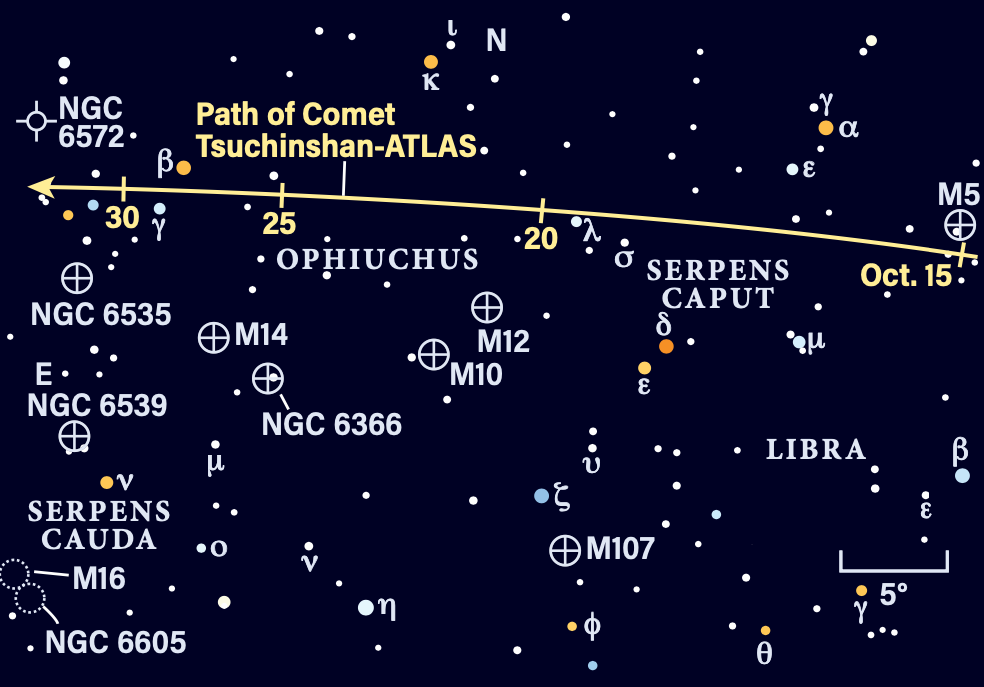
Sunday, October 27
C/2023 A3 (Tsuchinshan-ATLAS) is still stunning in the evening sky, now visible for several hours after sunset as it hangs above the horizon in central Ophiuchus.
The comet stands some 1.6° from magnitude 2.8 Cebalrai (Beta [β] Ophiuchi) tonight, just southwest of the star in the sky. It’s also roughly the same distance from the small, 11th-magnitude globular cluster NGC 6426, which lies east of the comet this evening. By tomorrow, Tsuchinshan-ATLAS will pass north of the cluster, coming within just ¼° and posing between the star and the deep-sky object — a lovely setup for astrophotographers.
The best way to spot Tsuchinshan-ATLAS is to go outside around 7 P.M. or 8 P.M. local daylight time, after the sky has grown darker following sunset. At that time, Tsuchinshan-ATLAS is still more than 30° high in the southwest, far above and slightly to the right of bright Venus, which sits close to the horizon and sets just before 8 P.M. local daylight time. Let your eyes adjust to the dark and, if you’re in an area free from light pollution, try scanning the sky without optical aid to see if you can find it. If not, a few-second exposure on your smartphone’s camera will certainly pick it up, so give it a try — snapping a few photos can help you locate the comet in the sky, and then you can try scanning the region again with your eyes. Even if you’re in a light-polluted area or simply can’t spot the comet with naked eyes, binoculars or a small telescope will easily show it.
Sunrise: 7:24 A.M.
Sunset: 6:03 P.M.
Moonrise: 2:41 A.M.
Moonset: 4:05 P.M.
Moon Phase: Waning crescent (19%)
Monday, October 28
Halloween is fast approaching — let’s get into the spooky season mood by hunting down an object from Astronomy contributor Stephen James O’Meara’s Ghost Hunt Challenge list. These select deep-sky objects shine on autumn nights, as opposed to the Messier marathon targets that stand out in the springtime sky.
Tonight, we’re hunting down the Blue Snowball (NGC 7662), a planetary nebula in the constellation Andromeda. Planetary nebulae are generated by dying Sun-like stars, which blow off their outer layers as they expand into giants, then leave their dense, white dwarf core behind to light those layers from within. Such nebulae only last a few tens of thousands of years at most — a cosmic eyeblink.
The Blue Snowball lies in far western Andromeda, some 70° high around 8 P.M. local daylight time tonight. It is just 2.4° west of 4th-magnitude Iota (ι) Andromedae, and glows softly at 9th magnitude. It’s best enjoyed with a larger telescope, but the nebula’s compact size — some 2’ in diameter, though the central regions span just 30” — means that its light is more concentrated, allowing smaller scopes to pick it up as well. As the name implies, the gas glows with bluish light, thanks to excited oxygen within the nebula.
Sunrise: 7:26 A.M.
Sunset: 6:02 P.M.
Moonrise: 3:41 A.M.
Moonset: 4:24 P.M.
Moon Phase: Waning crescent (13%)
Tuesday, October 29
The Moon reaches apogee, the farthest point from Earth in its orbit, at 6:50 P.M. EDT. It will then stand 252,377 miles (406,161 kilometers) away.
Early this morning is a great opportunity to enjoy the slim crescent Moon, less than 10 percent lit and standing 20° high in the east an hour before sunrise. The Moon is now located in western Virgo, with only the far western limb of our satellite currently directly illuminated by the Sun.
But wait — you might be able to easily make out the rest of the Moon’s nearside, even though it lies in Earth’s shadow. That’s because sunlight bouncing off the lit-up Earth can illuminate the darkened portion of Luna’s face, allowing us to see features that should otherwise be hidden. This phenomenon, called earthshine, makes the crescent Moon particularly beautiful to observe and photographs quite well.
This morning, the Moon is also not far from the famous double star Porrima (Gamma [γ] Virginis). The stars that make up this system are roughly the same magnitude — 3.65 and 3.56 — and currently sit about 3” apart. If you’ve got even a small telescope, swing it up toward this star before the sky grows too light to enjoy the sight as your eyepiece splits it into two.
Sunrise: 7:27 A.M.
Sunset: 6:00 P.M.
Moonrise: 4:40 A.M.
Moonset: 4:43 P.M.
Moon Phase: Waning crescent (7%)
Wednesday, October 30
Cygnus the Swan is still flying high after sunset, now in the south after the sky grows dark with no Moon to interfere. Look first toward the Swan’s brightest star, magnitude 1.3 Deneb, which anchors one of the three points that make up the Summer Triangle asterism.
Just over 3° east-southeast of Deneb is the mighty North America Nebula (NGC 7000), an emission nebula that covers some 10 times the area of the Full Moon in the sky. Stretching 2½° at its widest, this glowing swath of gas is separated from the nearby Pelican Nebula (IC 5070) by a lane of dark dust cataloged by Beverly Lynds as L935.
The North America Nebula is visible in larger binoculars as a noticeable bright spot near Deneb, while zooming in with a telescope will show more detail and fill your eyepiece with the glowing gas. Most observers recommend using a UHC filter to cut down on the light from nearby stars while bringing out the nebula’s rich detail, including its distinctive shape, which appears much like the continent for which it is named.
Sunrise: 7:28 A.M.
Sunset: 5:59 P.M.
Moonrise: 5:39 A.M.
Moonset: 5:03 P.M.
Moon Phase: Waning crescent (3%)
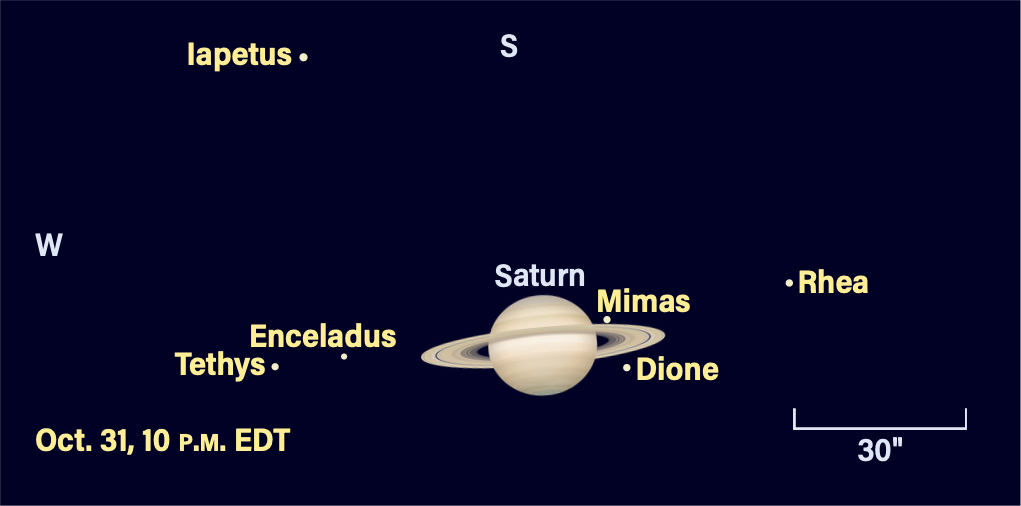
Thursday, October 31
Saturn’s moon Iapetus, now shining at 11th magnitude as it nears superior conjunction, is located 1’ southwest of the ringed planet this evening. It’s a great opportunity to spot the elusive moon, which spends most of its orbit far from the planet, and for half of its orbit appears a full magnitude fainter than it is now.
Saturn, glowing at magnitude 0.7, is in Aquarius. It hangs some 40° above the horizon in the south around 9 P.M. local daylight time. Zoom in with a telescope to search out its many moons, with several scattered near the rings tonight. In addition to Iapetus, 10th-magnitude Dione, Tethys, and Rhea are also visible; larger scopes may even show fainter Enceladus (12th magnitude), Mimas (13th magnitude), and Hyperion (14th magnitude, not shown in our illustration above).
But there’s more action in the solar system tonight — next, swing your scope over to Jupiter, where the Galilean moon Callisto will pass due south of the mighty world. Blazing Jupiter is magnitude –2.7 in Taurus and rises in the east around 8 P.M. local daylight time, slowly climbing higher between the horns of the Bull as the night progresses.
Jupiter’s three other Galilean moons — Io, Europa, and Ganymede — all transit in front of or become occulted behind the planet on a regular basis. But the tilt of the moons’ orbits and Callisto’s distance from Jupiter combine such that we see this farthest of the four bright moons pass above or below the planet instead.
Callisto’s trip south of Jupiter this evening lasts from about 8 P.M. EDT (as the planet is rising on the East Coast) to roughly 1 A.M. EDT. The moon stands due south of the planet’s southern pole around 10:15 P.M. EDT.
Sunrise: 7:29 A.M.
Sunset: 5:58 P.M.
Moonrise: 6:39 A.M.
Moonset: 5:24 P.M.
Moon Phase: Waning crescent (1%)
Friday, November 1
New Moon occurs this morning at 8:47 A.M. EDT.
With no Moon in the sky, see if you can spot the “false dawn” of the zodiacal light, now visible before the sun rises on autumn mornings. This cone-shaped glow is broadest at the horizon, thrusting upward in the east before the sky starts to lighten with the oncoming dawn. It follows the ecliptic, the plane of the solar system, stretching upward through Leo, Cancer, and Gemini. Its tip might even encompass the red glow of Mars, which now lies in western Cancer to the lower right of Castor and Pollux in the Twins.
You’ll need a viewing location where the eastern sky is free from light pollution, as the zodiacal light is only about as bright as the Milky Way and thus easily washed out by artificial lights. Try looking for it about two hours before dawn. The glow is created as sunlight scatters off myriad dust particles left in the inner solar system by comets passing through, forming tails as the Sun heats their icy surfaces. Eventually those particles settle along the ecliptic as they orbit the Sun, concentrating the light they scatter there.
Sunrise: 7:30 A.M.
Sunset: 5:57 P.M.
Moonrise: 7:41 A.M.
Moonset: 5:47 P.M.
Moon Phase: New

Sky This Week is brought to you in part by Celestron.


